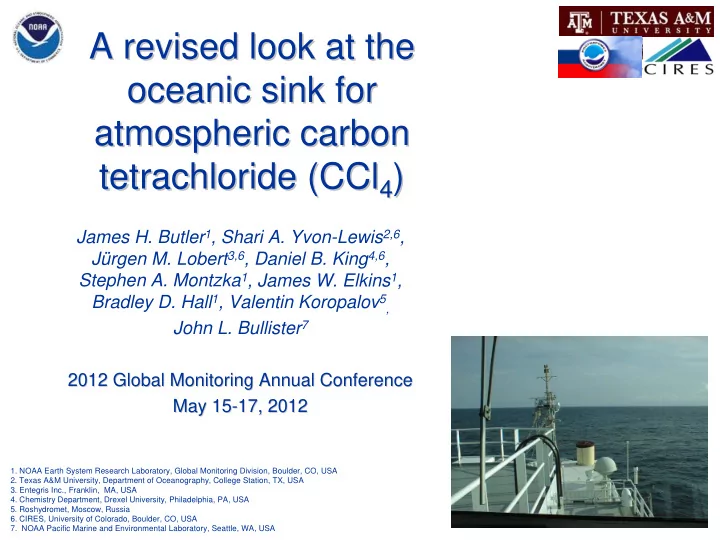

A revised look at the A revised look at the oceanic sink for oceanic sink for atmospheric carbon atmospheric carbon tetrachloride (CCl 4 ) tetrachloride (CCl 4 ) James H. Butler 1 , Shari A. Yvon-Lewis 2,6 , Jürgen M. Lobert 3,6 , Daniel B. King 4,6 , Stephen A. Montzka 1 , James W. Elkins 1 , Bradley D. Hall 1 , Valentin Koropalov 5 , John L. Bullister 7 2012 Global Monitoring Annual Conference 2012 Global Monitoring Annual Conference May 15- -17, 2012 17, 2012 May 15 1. NOAA Earth System Research Laboratory, Global Monitoring Division, Boulder, CO, USA 2. Texas A&M University, Department of Oceanography, College Station, TX, USA 3. Entegris Inc., Franklin, MA, USA 4. Chemistry Department, Drexel University, Philadelphia, PA, USA Oceanic Sink of CCl 4 ESRL GMAC 5. Roshydromet, Moscow, Russia JH Butler May 15 ‐ 17, 2012 6. CIRES, University of Colorado, Boulder, CO, USA 7. NOAA Pacific Marine and Environmental Laboratory, Seattle, WA, USA
Why is this important? • CCl 4 is a strong ozone-depleting gas for which most production has ceased. • Although its amount is declining In the atmosphere, the rate of decline is slower than its limited production and atmospheric lifetime (~26 y) suggest. • The oceanic sink is typically treated as a significant contributor to the lifetime of CCl 4 in the atmosphere, along with reaction in the stratosphere and loss to soils. Oceanic Sink of CCl 4 ESRL GMAC JH Butler May 15 ‐ 17, 2012
Purpose of this study • Re-examine the oceanic Research cruises contributing to this study sink to provide more confidence in our ability to estimate the rate of atmospheric CCl 4 removal by the ocean. With data from 16 cruises, this allows us to SAGA-2, RITS89, SAGA-3, OAXTC, BLAST1, BLAST2, provide a much more BLAST3, GasEx98, RB9906, CLIVAR01, A16N, A16S, PHASE, P18, GOMECC, HalocAST-P, HalocAST-A representative picture of oceanic removal rates. o 16 cruises o All oceans o All seasons o 23 years (1987-2010) Oceanic Sink of CCl 4 ESRL GMAC JH Butler May 15 ‐ 17, 2012
How did we do it? • Air samples were collected from the ship’s bow, surface samples were obtained with an underway, Weiss-type equilibrator, and, on many cruises, samples from hydrocasts were analyzed as well. • Samples were analyzed by gas chromatography with both ECD and mass spectrometric detection to evaluate potential analytical biases. • Depth profiles of CCl 4 were obtained on some cruises to identify potential zones of CCl 4 loss. • The minimum, pseudo-1 st -order degradation rate constant was used in the oceanic uptake model to determine the global uptake and partial atmospheric lifetime. Oceanic Sink of CCl 4 ESRL GMAC JH Butler May 15 ‐ 17, 2012
What did we find out? Southern Ocean Equatorial (BLAST 3; 1996) (SAGA-3; 1990) • CCl 4 is undersaturated in the surface ocean nearly everywhere, virtually all the time. • This undersaturation exceeds East Atlantic East Pacific (HalocAST-A; 2010) (BLAST 1; 1994) that which might be expected from physical effects, such as mixing of water masses. • The minimum, pseudo-1 st -order degradation rate constants needed to support the observed undersaturations, East & West Atlantic Atlantic, Coastal Pacific (BLAST 2 – 1994) assuming no in situ production, (GasEx-98; 1998) differ by only small amounts in various oceanic regions. Oceanic Sink of CCl 4 ESRL GMAC JH Butler May 15 ‐ 17, 2012
Are we sure? East Pacific HaloCAST-P; 2010) • Surface samples from hydrocasts (circles) vs. equilibrator measurements (spikes) suggest no sampling bias • Often, but not always, influences of physical effects make the Observed Anomaly Corrected Anomaly anomaly positive or less (PHASE; 2004) (PHASE; 2004) negative. For calculating fluxes, these effects from air injection, mixing, and thermal changes are corrected by subtracting observed CFC-11 surface anomalies. Oceanic Sink of CCl 4 ESRL GMAC JH Butler May 15 ‐ 17, 2012
What’s causing this undersaturation? • Relative concentrations of CCl 4 are consistently less than CFC-11 at intermediate depths, suggesting consumption 35.5ºS 40.5ºN as oxygen declines • CCl 4 seems to be consumed most rapidly in low-oxygen waters Data from the P18 cruise in the eastern Pacific show dramatically lower CCl 4 saturations vs CFC-11 saturations, especially in sub-surface waters with high Apparent Oxygen Utilization ( AOU). Oceanic Sink of CCl 4 ESRL GMAC JH Butler May 15 ‐ 17, 2012
What did we find out? • The oceanic sink is responsible for removing ~30% of the CCl 4 from the atmosphere, representing a partial atmospheric lifetime of 81y (vs 94y used in the WMO/UNEP Scientific Assessments). • Considering this sink and the removal of CCl 4 in the stratosphere, the mid-range estimate of the atmospheric lifetime of CCl 4 would be 25y (formerly 26y in the WMO/UNEP Scientific Assessments). Oceanic Sink of CCl 4 ESRL GMAC JH Butler May 15 ‐ 17, 2012
What does this all mean? • Irreversible removal of CCl 4 by processes within the ocean has a significant impact (~30%) on the lifetime of CCl 4 in the atmosphere reducing the length of time that stratospheric ozone would otherwise be impacted by Cl from this molecule. • CCl 4 removal could take place in the surface ocean, but there is considerable evidence in depth profiles that it is removed more rapidly at depth near the oxygen minimum. • The influence of the oceanic sink on the atmospheric lifetime is robust and well supported by observations and models. Oceanic Sink of CCl 4 ESRL GMAC JH Butler May 15 ‐ 17, 2012
Questions? Oceanic Sink of CCl 4 ESRL GMAC JH Butler May 15 ‐ 17, 2012
Recommend
More recommend